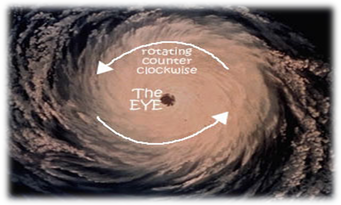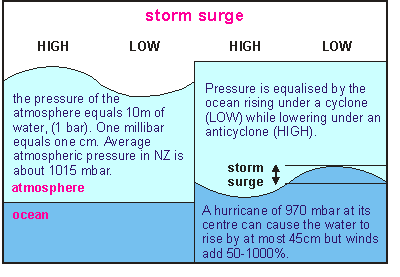
We are all aware about the Hurricane Katrina. What a disaster it was! It was one of the deadliest and most destructive disasters in the history of the United States. Hence, we can say that Hurricanes are the superlative form of storms. They are the only weather disasters that have been given their own names. Also, the energy that it releases is marvellous. It is estimated that every second it releases an energy which is equivalent to the energy released by 10 atomic bombs. The word Hurricane is derived from the Taino Native American word ‘hurucane’ which means ‘evil spirit of the wind’. One can distinguish a Hurricane from any tropical storm, cyclone, typhoon or a Tornado by the force of its wind. It is a Hurricane when the speed of the wind exceeds 74 miles per hour. Unlike Tornadoes, Hurricanes may last several days and is about 2,000 bigger.
Very little wind circulation and a bunch of thunderstorms is a tropical disturbance. However, when the wind speed is about 20 to 34 miles per hour, the tropical disturbance becomes a tropical depression. If the wind increases its force between 35 to 64 miles per hour, it becomes a tropical storm. When the speed of the wind reaches 74 miles per hour or greater than that, the mass of air grows and spins continually at the centre of the low pressure and is considered as a Hurricane. They are large storms and form over the oceans in the tropical climate regions. They are formed at the temperature differences between the warm water and the clouds. A column of fast and moving air is created when the clouds pull the moisture in the air near the surface of the water up towards them. They may have a diameter of about 400 to 500 miles and it brings huge waves and heavy rain, thereby hitting the land with tremendous force.

A Hurricane is different from various common types of extratropical cyclones in the United States. Beginning in the areas of low atmospheric pressure, they move off to Africa and Atlantic and get intensified in the moisture-laden air above the warm tropical ocean. Rotation is initiated in the converging windfields when the air moves from all directions toward these atmospheric lows and accordingly curves to the right under the influence of the Coriolis Effect. A potential self-enforcing feedback system is produced above this low-pressure area when these hot, moist air masses meet and rise up into the atmosphere, thereby forming Hurricanes. There is immense heat and energy in Hurricanes as they are gathered through contact with warm ocean waters and evaporation helps in increasing their power enabling it to last for several days. They rotate counter-clockwise around an ‘eye’ in the Northern Hemisphere and clockwise in the Southern Hemisphere. The calmest part of the storm is its ‘eye’. It has only fair weather and winds.

For a Hurricane to form:
There must be a pre-existing condition, disturbance with the thunderstorms. Water should be deep, up to 150 ft. and at least 80° F warm. There must be light upper-level winds.
When the sea level rises during the tropical cyclones, typhoons or Hurricanes, it is a storm surge. They are caused primarily due to the relationship between the ocean’s surface and the winds. The strong winds produced by the storms push the water into the shore which may lead to flooding. It is because of this that the storm surges are dangerous for coastal regions. When the winds are strongest, the level of water rises and is pushed in the direction where the winds are blowing. Atmospheric pressure is another factor that contributes to storm surge. It is higher at the edges of the storm than the centre.

Hurricane’s present intensity rating is based on the Saffir-Simpson Hurricane Scale. The scale rates the Hurricane between 1 to 5 estimating the property damage and flooding along the coast from a Hurricane landfall. The determining factor of the scale is the speed of the wind. It was developed by Herbert Saffir who is a civil engineer and Bob Simpson who is a meteorologist and was the director of the U.S. National Hurricane Centre (NHC) in the year 1971. It is categorised as:
-
Category One Hurricane: Winds with a speed of about 74 to 95 miles per hour are the Category One Hurricanes. It does not cause real damage to the building structures but damages the mobile homes. The storm surge in this category is generally 4 to 5 feet above normal.
-
Category Two Hurricane: Wind speed of 96 to 110 miles per hour are categorised as Category Two Hurricane. It causes considerable damage to shrubbery and trees and mobile homes. The coastal and low-lying flood about 2 to 4 hours before the arrival of the Hurricane centre. Storm surge is 6 to 8 feet above normal.
-
Category Three Hurricane: This category consists of hurricanes whose winds are about 111 to 130 miles per hour and its storm surge is generally 9 to 12 feet above normal. It may cause some structural damage to small residences and utility buildings. For these Hurricanes, evacuation of low-lying residences off the shoreline may be required.
-
Category Four Hurricane: Winds with 131 to 155 miles per hour are considered as Category Four Hurricanes. It leads to major damage to the lower floors of structures and may result in complete destruction on mobile homes. Its storm surge is generally 13 to 18 feet above normal.
-
Category Five Hurricane: Winds greater than 155 miles per hour and storm surge greater than 18 feet above normal are categorised as Category Five Hurricane. It may lead to complete roof failure on many residences and industrial buildings, complete destruction of mobile homes, severe and extensive window and door damage.
The most terrifying and disastrous Hurricanes are:
-
The Galveston Hurricane: On 8 September 1900, in the early evening, a Category Four Storm with a wind speed of more than 130 miles per hour roared the shores at Galveston, Texas.
-
San Felipe-Okeechobee Hurricane: Occurred at inland Lake Okeechobee, Florida in 1928, it caused an extensive destruction. It caused a lake to surge between 6 to 9 feet and led to about 1,836 deaths in the area.
-
Hurricane Camille: This was one of the most memorable Hurricanes that hit the Gulf Coast near Mississippi and Louisiana in 1969. It was the Category Five storm.
-
Hurricane Hugo: It led to a landfall to the north of Charleston on 22 September 1989 and was one of the worst storms that hit the coasts of Carolinas.
-
Hurricane Andrew: Before Hurricane Katrina, Hurricane Andrew was considered to be the most damaging storm in the history of the United States. It caused a damage of about 26.5 billion dollars and had the monstrous winds with the speed of 167 miles per hour.
-
Hurricane Katrina: Hurricane Katrina made a landfall on 29 August 2005 passing from the Caribbean and Florida. It was a Category Three Hurricane with a wind speed of 125 miles per hour. However, it was not as strong as the other destructive storms, it had been a Category Five hit, the day before it hit the land.


